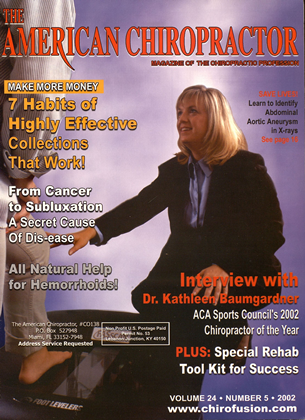The competitive and the recreational athlete can each be affected by injuries to the muscles and ligaments around the hip. These injuries can significantly interfere with sports enjoyment and performance levels, and they occasionally will end participation completely. Poor shock absorption and excessive pronation have been found to be underlying causes or contributing factors for many leg/hip in- juries.' Orthotics which have been custom made to improve the biomechanics of the feet and reduce the extent of prona-tion can help to prevent many sport-related leg injuries. Excessive Foot Pronatlon a Factor Busseuil, el al., looked at the foot biomechanics of athletes who reported a recent foot or leg injury, and compared them to an uninjured control group.2 Sixty-six injured athletes who ran at least once a week, and who had no history of traumatic or metabolic factors, were the study group. Another (control) group of 216 athletes were matched who had no symptoms of lower extremity injuries. The amount of pronation during standing and while running at "regular speed" was determined by measuring the angles of their footprints. This quick and inexpensive method of determining the amount of pr-onation during functional activities (j)lan-tar prints) had been previously investigated.3 The researchers determined that those athletes with more foot pronation had a much greater statistical probability of sustaining one of five leg injuries, including iliotibial band syndrome. This study helps remind us that it is very important to athletic performance and for injury prevention to check the alignment of patients' feet in the standing position. It also helps us understand how providing appropriate orthotic support to athletic/highly active patients lowers their likelihood of developing both traumatic and overuse hip injuries. Hip Injuries and Hamstring Control Many hip injuries develop from poor biomechanics and gait asymmetry, especially when running. Smooth coordination of the muscles that provide balance and support for the pelvis is needed for optimum bipedal sports performance. The hamstrings are a good example. During running, the hamstrings are most active during the last 25% of the swing phase, and the first 50% of the stance phase.4 This initial 50% of stance phase consists of heel strike and maximum pronation. The hamstring muscles function to control the knee and ankle at heel strike and to help absorb some of the impact. A recent study has shown a significant decrease in electromyographic activity in the hamstrings when wearing orthotics.5 In fact, these investigators found that the biceps femoris—which is the most frequently injured of the three hamstring muscles6—had the greatest decrease in activity of all muscles tested, including the tibialis anterior, the medial gastrocnemius, and the medial and lateral vastus muscles. The authors of this study theorized that the additional support from orthotics helped the hamstrings to control the position of the calcaneus and knee, so there was much less stress into the hip joint and pelvis. Hip Injuries and Excessive Pronation The following is a list of the pathologies that are seen in the hip and pelvis secondary to pronation and foot hypermobility:7 These conditions will develop much more easily in athletes who push their musculoskeletal systems, in order to achieve greater functional performances. Conclusion Excessive pronation and/or poor shock absorption have been shown to be associated or causative factors in many lower-extremity injuries—from the foot to the hip joint. Evaluation of foot biomcchan-ics is especially necessary for competitive athletes and patients who are recreationally active, or for anyone who has experienced hip problems. Preventive measures include wearing well-designed and solidly constructed shoes. In addition, custom-made orthotics help prevent arch breakdown and biomechanical foot problems, which can lead to numerous injuries to the lower extremities, including the hip joints. | Dr. John Danchik is the seventh inductee to the American Chiropractic Association Sports Hall of Fame. He is the current chairperson of the United States Olympic Committee s Chiropractic Selection Program, and lectures extensively in the United States and abroad on current trends in sports chiropractic and rehabilitation. Dr. Danchik is an associate editor of the Journal of the Neuromusculoskeletal System and the Journal of Chiropractic Sports Injuries and Rehabilitation, and has been in private practice in Massachusetts for 24 years. You may reach Dr. Dane/tick at (617)-489-l220 or e-mail docforjocs(5)anl. com. See page 50 for References Hip and Pelvis Pathologies secondary to pronatlon and foot hypermoblllty: Anterior pelvic tilt Hip adductor muscle strain Hip flexor muscle strain Hip joint capsulitis Iliotibial band syndrome Piriformis muscle strain Tensor fascia lata strain Trochanteric bursitis ORTHOTICS-Pg 34 Athletes and Hop Injuries: Can Orthotlcs Help? by John Danchlk, D.C., CCS.P., F.I.C.C Dahle LK. el <;/.. Visual assessment of foot type and relationship of foot type to lower extremity injury. ./ Orthop Sports I'hys Thvr 1991; 14:70-74. Husscuil C. et til.. Rearfoot-forefoot orientation and traumatic risk for runners. Fool Ankle lull 1998; 19:32-37. Ireychat P. el <//.. Relationship between rearfoot and forefoot orien tation and ground reaetion forces during running. Med Sci Sports Exere 1996; 28:225-232. Mack RP. AAOS Symposium on the Foot and Leg in Running Sports. St. Louis: Mosby; 1982. Nawoczenski DA. l.udewig I'M. I'lectromyographic effects of foot orthotics on selected lower extremity muscles during running. Arch I'hys Meet Kehiihil 1999; 80:540-544. Garrett WR, Muscle strain injuries. Am J Spoils Med 1996; 24:S2-8. 7. Hartley A, Practical Joint Assessment: A Sports Medicine Manual. St. Louis: Mosby YcarBook; 1991:571.
 View Full Issue
View Full Issue






